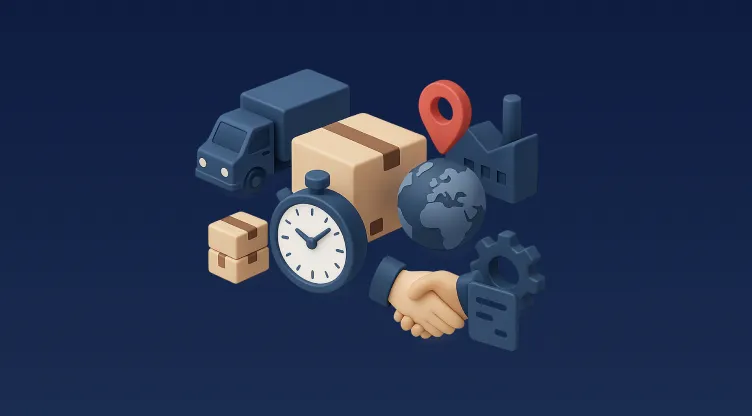Introduction: Why Visibility is the Backbone of Modern Supply Chains
In today's volatile global marketplace, supply chains are under more pressure than ever. Whether it’s navigating geopolitical tensions, coping with disruptions like the COVID-19 pandemic, or adapting to fast-evolving consumer demands, one thing remains clear: supply chain visibility is no longer optional—it's a competitive necessity.
For businesses operating in the MENA region, this need is amplified. With complex cross-border logistics, high import/export volumes, and increasing demand for hyperlocal and eCommerce delivery models, having an end-to-end view of your supply chain—from procurement to last-mile delivery—is essential. This is where supply chain visibility tools step in, serving as the digital backbone that supports proactive decision-making and effective risk management plans.
In this guide, we’ll explore how modern visibility solutions enable real-time tracking, strengthen operational resilience, and reshape supply chain strategy in the MENA logistics ecosystem.
The Visibility Imperative: What It Really Means
Supply chain visibility refers to the ability to track every component, shipment, and activity across your supply chain, in real-time. This includes raw materials, inventory, shipments, and even partner performance.
End-to-end visibility provides businesses with a centralised platform to monitor:
- Inventory levels across multiple hubs
- Inbound and outbound shipments
- Order fulfilment statuses
- Carrier performance and location tracking
- Exceptions and delays in real-time
By having this 360-degree insight, organisations can react swiftly to disruptions, reduce operational bottlenecks, and execute a robust risk management plan.
Why MENA Supply Chains Face Unique Visibility Challenges
The MENA region is a dynamic and high-growth logistics zone—but it's also uniquely complex:
- Multiple border regulations between GCC countries
- Fragmented logistics infrastructure across urban and rural areas
- High dependency on imports and international freight
- Rapid digitalisation in retail and eCommerce, driving demand for last-mile excellence
This creates an environment where manual or outdated systems fall short. Without real-time insights, businesses often suffer from stockouts, delayed deliveries, and mounting operational costs.
A regional logistics director summed it up best: "Without visibility, you're operating blind in a high-stakes environment."
Core Benefits of Supply Chain Visibility Tools
Real-Time Inventory Tracking
Modern tools such as Omniful’s WMS provide multi-hub inventory visibility. This means businesses can track inventory at various stages—available, reserved, in-transit, or back storage. Real-time syncing with marketplaces ensures inventory accuracy across all channels, reducing overselling or underselling risks.
Shipment & Carrier Monitoring
Advanced Transportation Management Systems (TMS) offer real-time GPS tracking of shipments, delivery vehicles, and driver locations. Businesses gain insights into expected delivery times, delays, and anomalies—enabling proactive responses and customer updates.
Enhanced Forecasting & Demand Planning
With AI-powered analytics, tools can anticipate demand surges, helping organisations prepare stock levels and staffing accordingly. This is crucial in regions like Saudi Arabia, where demand fluctuates drastically during Ramadan or Hajj seasons.
Exception Management & Alerts
Smart systems flag issues as they arise. Whether it's a delayed shipment, temperature deviation for perishable goods, or a missed scan, exception handling helps address problems before they escalate.
Use Case: How Omniful Elevates Visibility in the MENA Region
Aramex: Scaling 3PL Fulfilment with Real-Time Control
A leading logistics giant, Aramex partnered with Omniful to launch 3PL fulfilment from over 100 dark stores in Saudi Arabia. They faced challenges integrating with existing systems and managing diverse client needs.
With Omniful’s OMS + WMS + TMS stack:
- They achieved real-time inventory syncing with marketplaces
- Integrated with Infor WMS for advanced inventory routing
- Gained full visibility into every SKU and shipment
- Enabled branded dashboards for merchant transparency
Outcome: Reduced delays, improved merchant satisfaction, and faster fulfilment across KSA.
Laverne Group: In-house Fulfilment for Speed and Accuracy
Previously relying on 3PLs, the Laverne Group (D2C brands in KSA) faced service inconsistencies. Omniful’s integrated platform enabled them to:
- Go live in just 3 weeks
- Run 2 warehouses and 4 dark stores
- Reduce order-to-delivery time from 4–6 days to 2–3 hours in Riyadh
- Achieve 100% inventory accuracy
How Visibility Supports Better Risk Management
A strong risk management plan involves identifying vulnerabilities, assessing their impact, and setting controls to mitigate disruption. Visibility tools act as the core enabler of this plan in three key ways:
Predictive Insights
Using AI and analytics, businesses can anticipate disruptions—be it supplier delays, logistics backlogs, or demand spikes—and take pre-emptive actions.
Scenario Modelling
Advanced platforms simulate what-if scenarios. For example, what if a key supplier in Egypt halts delivery? How will it affect stock levels in Dubai? With the right data, businesses can evaluate risks before they occur.
Compliance & Documentation
With digital GRNs, PO tracking, and batch/lot management, visibility tools ensure regulatory compliance and full audit trails. This is critical in markets like the UAE or KSA where customs and food safety standards are strict.
What Features to Look for in a Visibility Tool
When evaluating supply chain visibility tools for your MENA operations, ensure they include:
- Real-time shipment tracking (last-mile, middle-mile, first-mile)
- Geofencing and delivery zone mapping
- Multi-hub inventory synchronisation
- Integration with major sales channels like Salla, Zid, Shopify
- Mobile operations apps (iOS/Android)
- Vendor and purchase order management
- AI-powered demand forecasting and route optimisation
- Alerts and exception dashboards
Omniful, for instance, offers an integrated suite with WMS, OMS, TMS, and Supply Chain modules tailored for high-growth MENA businesses.
How Supply Chain Visibility Shapes Strategy
Adopting visibility tools isn’t just about crisis management—it’s a strategic move. Here’s how:
Enables Agile Supply Chain Strategies
Companies can shift from reactive to proactive. With live data, they can reroute orders, rebalance inventory across hubs, or launch demand-triggered replenishment campaigns.
Improves Customer Satisfaction
Real-time updates, accurate ETAs, and reduced stockouts lead to better customer experiences—especially vital for online retail and Q-commerce brands.
Reduces Costs
By eliminating inefficiencies, visibility tools reduce fuel wastage, warehouse idling, and labour redundancies. They also help avoid penalty costs from SLA breaches.
Supply Chain بالعربي: Visibility in the Local Context
In MENA, the term "سلسلة الإمداد" (Supply Chain بالعربي) is gaining traction, especially among logistics professionals and business owners seeking Arabic-first solutions.
Omniful supports this localisation by:
- Offering Arabic dashboards for merchants
- Providing support for Arabic-speaking warehouse staff
- Ensuring compliance with GCC regulations like ZATCA invoicing (KSA)
- Supporting local carriers and payment gateways
For regional players, having tools that speak their language—literally and operationally—is a game-changer.
Future Outlook: AI and IoT in Supply Chain Visibility
As we look ahead, the future of supply chain visibility in MENA will be shaped by:
- AI Copilots for inventory optimisation and route planning
- IoT sensors on packages for real-time temperature and movement tracking
- Blockchain for traceability, especially in pharma and food logistics
- Unified data lakes to centralise insights across WMS, OMS, and TMS
Platforms like Omniful are already investing in these technologies, ensuring businesses stay ahead in a rapidly evolving landscape.
Conclusion: Visibility is the New Currency of Trust
As MENA businesses scale their operations and expand across borders, the ability to see, sense, and respond in real time becomes a differentiator.
Supply chain visibility tools empower brands to build resilience, elevate customer experience, and future-proof their operations. Whether you’re a D2C brand in Riyadh, a 3PL in Dubai, or a retailer across the Gulf, visibility is your greatest ally in executing a world-class supply chain strategy.
FAQs
What is a supply chain visibility tool?
It’s a digital platform that allows businesses to track inventory, shipments, and supplier activity across the entire supply chain in real time.
How does it improve risk management?
By providing alerts, predictive insights, and real-time tracking, it helps businesses mitigate disruptions and improve contingency planning.
Are there tools designed specifically for MENA supply chains?
Yes, Omniful is a key player offering Arabic-first, MENA-ready solutions with native integrations for local carriers, regulations, and marketplaces.
Is real-time tracking expensive to implement?
Not necessarily. Cloud-based platforms like Omniful offer flexible pricing, and their ROI often offsets the cost through reduced delays, errors, and customer churn.
Can it support multi-brand and multi-location operations?
Absolutely. Modern platforms offer features like multi-hub inventory syncing, batch tracking, and demand forecasting for high-volume, multi-brand enterprises.























